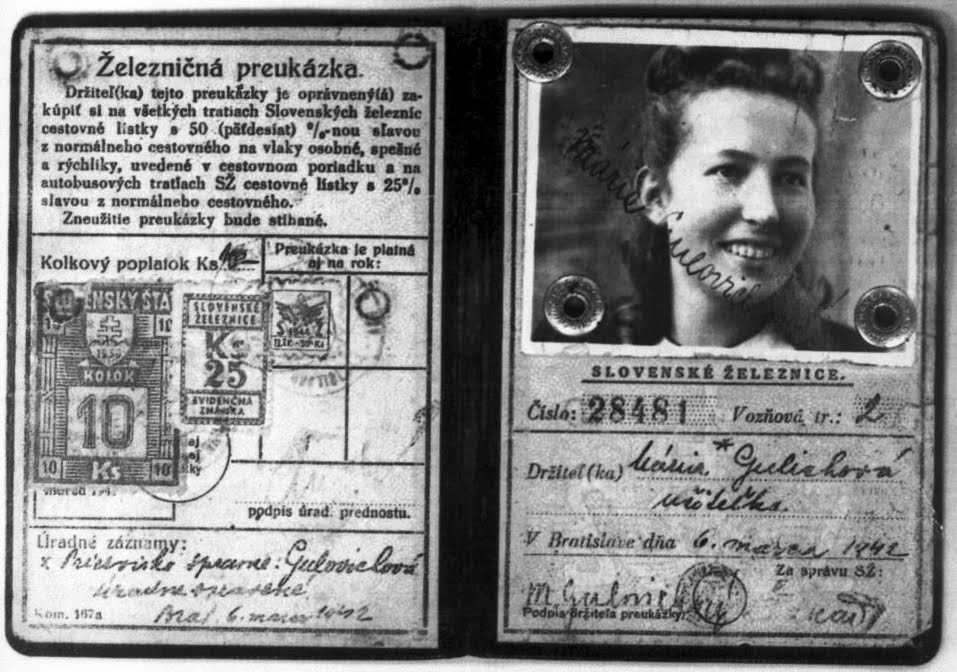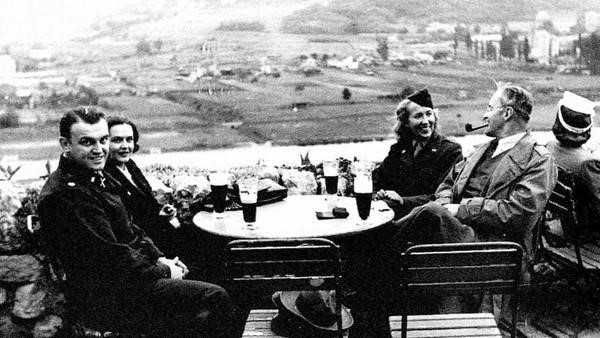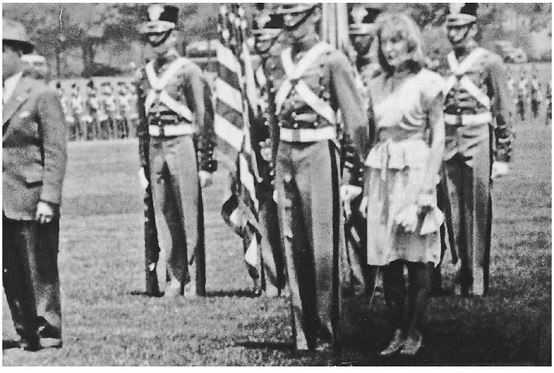Maria Gulovich, a young Slovakian schoolteacher, was only 23-years-old when she began harboring Jews from the Nazis. She joined the underground resistance and began working for the Office of Strategic Services (OSS) as a guide and interpreter.
Maria repeatedly risked her life to assist the OSS, including guiding a small group of American and British intelligence officers for nine weeks through the rugged mountains of Slovakia, in a blizzard, while being hunted by Nazis.
Her bravery and her indomitable spirit caught the attention of OSS Director William “Wild Bill” Donovan and future CIA Director Allen Dulles, who helped Maria become a US citizen in 1952. Maria was also the first woman to be honored with a review of cadets at the historic US Military Academy at West Point, where she was awarded the Bronze Star for her heroic service on behalf of the United States.

Maria Gulovich, ID card. 1942.
The Slovak Schoolteacher
Maria was born on October 19, 1921, in Jakubany, Slovakia. Her father was a Greek Orthodox Catholic priest and her mother was an elementary school teacher.
When Slovakia fell under German control in 1939, Maria was attending the Greek Catholic Institute for Teachers in Prešov. In 1940, she became a teacher and taught in Jarabina and later in Hriňová.
In 1944, Maria’s uneventful life as a school teacher changed forever.
Assisting the Resistance
One day, Maria’s sister, Marta, and a Jewish family friend named Julius Goldberger paid her a visit at the school in Hriňová. Julius operated a nearby lumber mill, and because the Germans considered him and his mill useful, he was not sent to a concentration camp.
Julius had been hiding his sister and nephew from the Germans for some time until he came under suspicion. He and Marta pleaded with Maria to hide his relatives.
Maria reluctantly agreed, realizing that if she were caught, it could mean imprisonment or worse.
It wasn’t long before the Slovakian authorities began to suspect Maria of harboring Jews.
A Slovak Army captain showed up at the school to question Maria. Fortunately for her, the captain was part of the anti-fascist resistance. The captain offered to hide the Jewish woman and her son if Maria would join the resistance as a courier.
Maria agreed and was ordered to move to Banská Bystrica where she would work as a dressmaker for an underground sympathizer.
On her first mission, Maria was sent to a town 65 miles away to retrieve a suitcase. Maria didn’t find out until 1989 that the suitcase contained a radio.
If she had been caught, the consequences would have been severe. She had a few close calls with the Gestapo on the return trip, but quick thinking and a little flirting got her out of trouble.
In addition to her talents as a courier, Maria was fluent in five languages — Russian, Slovak, Hungarian, German, and English. Once this was discovered, Maria was assigned to translate messages from Slovak into Russian for a Russian military intelligence group.
During her time working for the Russians, Maria met some American OSS officers who were assisting the resistance and rescuing some downed American airmen.
By October 1944, the Germans crushed the uprising and Maria and the Russians fled to the mountains to escape. There, Maria ran into her American friends again. They, too, had headed to the mountains to evade the Germans.
Maria and the Americans became friendly, and it wasn’t long before they asked her to join their group as a guide and interpreter for what the OSS called the DAWES mission. She wasn’t comfortable working for the Russians, so she eagerly accepted.
Escaping the Nazis
Maria’s work for the OSS DAWES mission included scouting for food and intelligence, and scoping out their surroundings.
She would pose as a peasant girl and go down into the towns to talk to the villagers. Often, Maria’s job led her right into danger in the form of German soldiers patrolling the roads. Her quick wit and skill with the German language got her out of many a scrape.
One of the greatest dangers in the Slovak mountains was the weather, and the elements struck mercilessly during a blizzard in November 1944. The wind blew so hard that it knocked people off their feet. The weary group didn’t dare stop. They passed 83 souls who tried to rest and froze to death.

Maria Gulovich, right, with Allen Dulles smoking a pipe, in Prague. 1945.
One of the greatest dangers in the Slovak mountains was the weather, and the elements struck mercilessly during a blizzard in November 1944. The wind blew so hard that it knocked people off their feet. The weary group didn’t dare stop. They passed 83 souls who tried to rest and froze to death.
The group finally reached the hunting lodge on Mount Dumbier, where they were to meet other British and American members of the DAWES team, including Associated Press reporter Joe Morton. It was almost Christmas and the group was waiting for provisions and supplies to be air dropped.
As the days passed, Maria, Joe Morton, and some of their companions grew concerned about their safety. They were right to be worried. An elite German unit was sent to track down the DAWES mission.
Maria and her group planned to leave on Christmas, but were delayed a day.
On December 26, 1944, Maria, two OSS officers, and two British airmen set out to find food and medical supplies further up the mountain. Joe walked with them for a bit, then returned to the camp.
Shortly after the small group left, the Germans surrounded the lodge, burned it to the ground, and captured the Americans, including Joe Morton. They were all taken to the Mauthausen-Gusen concentration camp, where they were tortured and killed on January 24, 1945.
Maria and the small group escaped into the mountains toward the Russian front in Romania as quickly as they could. They slept in barns and mines, suffered from frostbite and lice. It took them nine weeks of hiking through the bitter cold to reach safety.
Once Maria reached Bucharest, Romania, in early March, she was transferred to the OSS branch in Italy so she could continue to be paid for her work.
Years after their escape, Maria’s companions remembered her with fondness. During an interview, an Army sergeant who escaped with Maria called her “our little sweetheart … for whom I am and will be grateful forever. To her, it is no doubt that I owe my safety and perhaps my life.”
Becoming an American Citizen
After the war, Maria met Allen Dulles who was the OSS chief in Switzerland at time, and later became the Director of Central Intelligence. Dulles informed OSS head Gen. William “Wild Bill” Donovan of Maria’s courageous feats, and Donovan arranged for Maria to migrate to the United States with a scholarship to Vassar College.

Maria Gulovich, West Point, 1946.
In May 1946, Donovan presented Maria with the Bronze Star for her service with the OSS during World War II. She was the first woman to receive a medal on the Plain of West Point in front of the Corps of Cadets.
In 1952, Maria became a US citizen and settled in Oxnard, California. She established an excellent reputation as a real estate agent in Ventura County, California.
Maria Gulovich died on September 25, 2009 at the age of 87.
